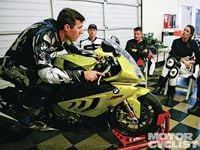When I'm coaching at the California Superbike School, riders will generally tell me what areas they'd like to improve. At the risk of repeating myself, they want more confidence and would like to be smooth and in control.
How did they discover this? While riding they had an uncertain moment or made a false/mistimed control input. What we tend to notice are symptoms rather than root causes of these missteps and uncertainties. Once an error is unfolding, it is the exceptional rider who can identify exactly what went wrong two steps before. The current error—“I’m running wide,” for example—typically captures all of his attention and he mentally sticks right there. He’ll more than likely think he was going too fast, which is almost never the real reason.
Then we have the one-in-a-hundred rider who just wants to be _told _what to do; where to improve. It’s a very visceral question—he’s feeling it and has got a desperate need to know. In this case, a professional coach must possess some of the “milk of human kindness.” If I honestly told a rider _everything _he was doing “wrong,” it could easily break his spirit. Not only that; riders rarely make significant improvement unless they concentrate on one aspect of their technique at a time.
A Pro racer requires a whole ’nuther category of coaching. Here’s a typical scenario: In a three- or four-corner section of track, about 20 seconds in length, he wants to find two-tenths of a second. That’s how much time it takes you to snap your fingers twice as quickly as you can. And just as with the rest of us, even a seasoned Pro tends to look at symptoms rather than causes.
It's clear to me that there is no greater multi-tasking sport than motorcycling. The art of cornering is indeed very similar to any other art form: One seeks to arrive at the point where every control input (or brush stroke) fits with every other to create a unified whole. This creates smooth and confident riding (and _inspiring _art).
A professional coach must be able to see not only what the error was, but exactly which technical skills were deficient to bring it about. Additionally, he must know why these errors happen and how best to repair them. He must have a keen sense of where the rider is in the big picture of the core skills of riding. His ability to gently coax the rider through the stages of coming to his own awareness of how good it can get is the art of coaching.











/cloudfront-us-east-1.images.arcpublishing.com/octane/HXOUJXQWA5HBHGRO3EMJIGFMVI.jpg)

/cloudfront-us-east-1.images.arcpublishing.com/octane/3TIWWRV4JBBOLDVGRYECVVTA7Y.jpg)
/cloudfront-us-east-1.images.arcpublishing.com/octane/KIX5O23D5NAIBGFXBN3327DKZU.jpg)
/cloudfront-us-east-1.images.arcpublishing.com/octane/7GJYDUIPXRGMTMQKN6ONYOLBOU.jpg)
/cloudfront-us-east-1.images.arcpublishing.com/octane/MUQLOVLL2ZDGFH25ILABNBXKTI.jpg)
/cloudfront-us-east-1.images.arcpublishing.com/octane/TNOU5DNE2BC57MFPMGN2EIDXAM.jpg)
/cloudfront-us-east-1.images.arcpublishing.com/octane/GTCXACQGJ5HAPDTGWUQKDEH44E.jpg)
/cloudfront-us-east-1.images.arcpublishing.com/octane/S35YGSEMEZB4BLTDJTSZPF4GLA.jpg)
/cloudfront-us-east-1.images.arcpublishing.com/octane/5UOT6HPX2JFMRJAX6EH45AR4MQ.jpg)
/cloudfront-us-east-1.images.arcpublishing.com/octane/OKWOJWAKP5EP3OACCRRWPCIX2Q.jpg)
/cloudfront-us-east-1.images.arcpublishing.com/octane/2WF3SCE3NFBQXLDNJM7KMXA45E.jpg)
/cloudfront-us-east-1.images.arcpublishing.com/octane/G4MG6OUCJNBSHIS2MVVOTPX65E.jpg)
/cloudfront-us-east-1.images.arcpublishing.com/octane/IIGGWFOTOJGB7DB6DGBXCCMTDY.jpg)
/cloudfront-us-east-1.images.arcpublishing.com/octane/QSTCM6AVEZA5JJBUXNIQ3DSOF4.jpg)
/cloudfront-us-east-1.images.arcpublishing.com/octane/U4I7G625B5DMLF2DVIJDFZVV6M.jpg)
/cloudfront-us-east-1.images.arcpublishing.com/octane/B6XD6LS6IVCQPIU6HXDJSM3FHY.jpg)
/cloudfront-us-east-1.images.arcpublishing.com/octane/ICL63FEDDRDTTMINYICCEYGMDA.jpg)
/cloudfront-us-east-1.images.arcpublishing.com/octane/FCGZHQXRBZFLBAPC5SDIQLVF4I.jpg)
/cloudfront-us-east-1.images.arcpublishing.com/octane/WNOB6LDOIFFHJKPSVIWDYUGOPM.jpg)

/cloudfront-us-east-1.images.arcpublishing.com/octane/X33NU3E525ECRHXLNUJN2FTRKI.jpg)
/cloudfront-us-east-1.images.arcpublishing.com/octane/6KKT5NNL2JAVBOXMZYS5ZO76YA.jpg)
/cloudfront-us-east-1.images.arcpublishing.com/octane/J5RKG5O455GMPGQRF2OG6LRT7A.jpg)